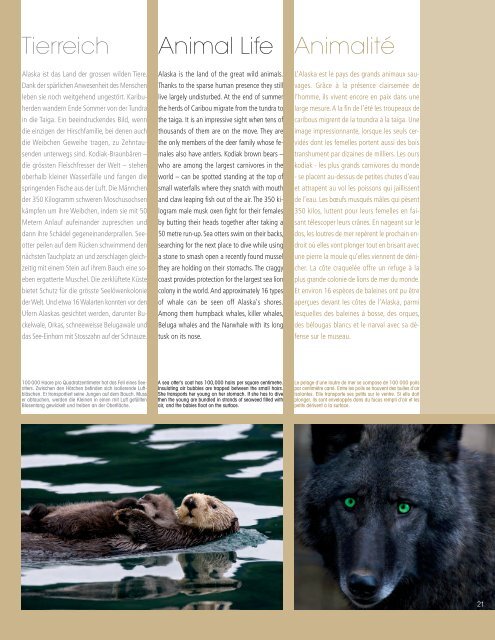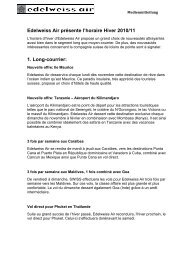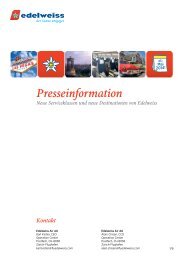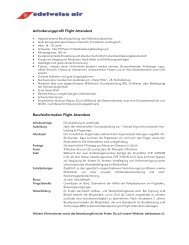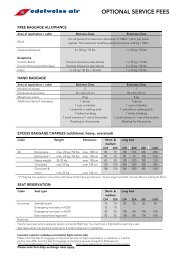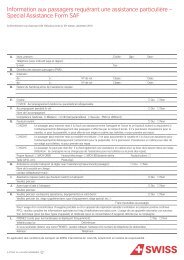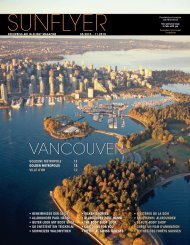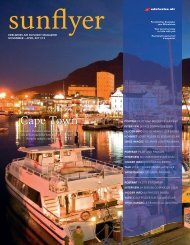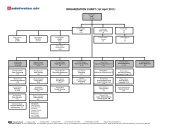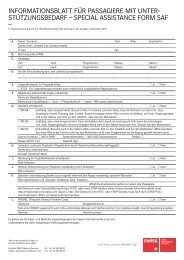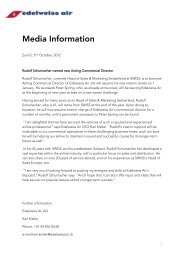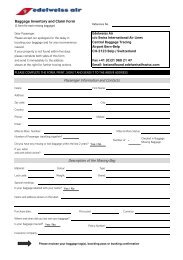ANCHORAGE - Edelweiss Air
ANCHORAGE - Edelweiss Air
ANCHORAGE - Edelweiss Air
- No tags were found...
You also want an ePaper? Increase the reach of your titles
YUMPU automatically turns print PDFs into web optimized ePapers that Google loves.
TierreichAlaska ist das Land der grossen wilden Tiere.Dank der spärlichenAnwesenheit des Menschenleben sie noch weitgehend ungestört. Karibuherdenwandern Ende Sommer von der Tundrain die Taiga. Ein beeindruckendes Bild, wenndie einzigen der Hirschfamilie, bei denen auchdie Weibchen Geweihe tragen, zu Zehntausendenunterwegs sind. Kodiak-Braunbären –die grössten Fleischfresser der Welt – stehenoberhalb kleiner Wasserfälle und fangen diespringenden Fische aus der Luft. Die Männchender 350 Kilogramm schweren Moschusochsenkämpfen um ihre Weibchen, indem sie mit 50Metern Anlauf aufeinander zupreschen unddann ihre Schädel gegeneinanderprallen. Seeotterpeilen auf dem Rücken schwimmend dennächsten Tauchplatz an und zerschlagen gleichzeitigmit einem Stein auf ihrem Bauch eine soebenergatterte Muschel. Die zerklüftete Küstebietet Schutz für die grösste SeelöwenkoloniederWelt. Und etwa 16Walarten konnten vor denUfern Alaskas gesichtet werden, darunter Buckelwale,Orkas, schneeweisse Belugawale unddas See-Einhorn mit Stosszahn auf der Schnauze.Animal LifeAlaska is the land of the great wild animals.Thanks to the sparse human presence they stilllive largely undisturbed. At the end of summerthe herds of Caribou migrate from the tundra tothe taiga. It is an impressive sight when tens ofthousands of them are on the move. They arethe only members of the deer family whose femalesalso have antlers. Kodiak brown bears –who are among the largest carnivores in theworld – can be spotted standing at the top ofsmall waterfalls where they snatch with mouthand claw leaping fish out of the air. The 350 kilogrammale musk oxen fight for their femalesby butting their heads together after taking a50 metre run-up. Sea otters swim on their backs,searching for the next place to dive while usinga stone to smash open a recently found musselthey are holding on their stomachs. The craggycoast provides protection for the largest sea lioncolony in the world.And approximately 16 typesof whale can be seen off Alaska's shores.Among them humpback whales, killer whales,Beluga whales and the Narwhale with its longtusk on its nose.AnimalitéL’Alaska est le pays des grands animaux sauvages.Grâce à la présence clairsemée del’homme, ils vivent encore en paix dans unelarge mesure.A la fin de l’été les troupeaux decaribous migrent de la toundra à la taïga. Uneimage impressionnante, lorsque les seuls cervidésdont les femelles portent aussi des boistranshument par dizaines de milliers. Les ourskodiak - les plus grands carnivores du monde- se placent au-dessus de petites chutes d’eauet attrapent au vol les poissons qui jaillissentde l’eau. Les bœufs musqués mâles qui pèsent350 kilos, luttent pour leurs femelles en faisanttélescoper leurs crânes. En nageant sur ledos, les loutres de mer repèrent le prochain endroitoù elles vont plonger tout en brisant avecune pierre la moule qu’elles viennent de dénicher.La côte craquelée offre un refuge à laplus grande colonie de lions de mer du monde.Et environ 16 espèces de baleines ont pu êtreaperçues devant les côtes de l’Alaska, parmilesquelles des baleines à bosse, des orques,des bélougas blancs et le narval avec sa défensesur le museau.100 000 Haare pro Quadratzentimeter hat das Fell eines Seeotters.Zwischen den Härchen befinden sich isolierende Luftbläschen.Er transportiert seine Jungen auf dem Bauch. Musser abtauchen, werden die Kleinen in einen mit Luft gefülltenBlasentang gewickelt und treiben an der Oberfläche.A sea otter's coat has 100,000 hairs per square centimetre.Insulating air bubbles are trapped between the small hairs.She transports her young on her stomach. If she has to divethen the young are bundled in strands of seaweed filled withair, and the babies float on the surface.Le pelage d’une loutre de mer se compose de 100 000 poilspar centimètre carré. Entre les poils se trouvent des bulles d’airisolantes. Elle transporte ses petits sur le ventre. Si elle doitplonger, ils sont enveloppés dans du fucus rempli d’air et lespetits dérivent à la surface.21


